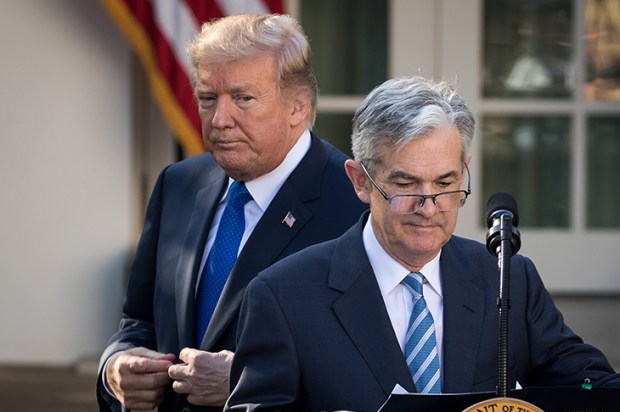William Martin is the longest-serving Federal Reserve chief, having held the role from 1952 to 1970. In 1964, Lyndon Johnson, the fourth of Martin’s five presidents, enacted fiscal stimulus only to see the US central bank resist pressure to keep interest rates low.
In 1965, Johnson upped the bullying. The president summoned Martin to his Texas ranch where Johnson ‘shoved him around his living room, yelling in his face: “Boys are dying in Vietnam and Bill Martin doesn’t care,”’ one history recounts. Martin seems to have buckled. When his final term ended, inflation was six per cent and climbing to double-digits.
Federal Reserve Chair Jerome Powell is suffering similar bullying ahead of the general election in November. The difference, however, is both sides of politics are applying pressure.
The economic backdrop is this. Eleven increases over 2022 and 2023 lifted the US cash rate from a record low 0.1 per cent to a 23-year high of 5.3 per cent. A few months ago, investors thought the Fed this year would conduct six rate cuts of a quarter point because annual inflation had cooled from 9.1 per cent in mid-2022 to 3.1 per cent in January. The Fed has an inflation target of 2 per cent.
Democrats hope rate cuts will embellish the economic credentials of President Joe Biden. Democrat cheerleaders say inflation is low enough for the Fed to prune rates to ensure consumer angst about the economy doesn’t become self-fulfilling. Democrat senators have written to Powell urging him to lop rates to alleviate housing costs. Others warn lower rates are needed to prevent a commercial property crash and the resultant financial instability.
The case against rate cuts is that ‘huge fiscal spending, the trillions needed each year for the green economy, the remilitarisation of the world and the restructuring of global trade… are inflationary,’ to quote Jamie Dimon, JPMorgan Chase CEO.
Recent economic reports confirm such concerns – the pivotal one showed US inflation accelerated to 3.5 per cent in March. Such setbacks mean investors expect fewer rate reductions this year. Market pricing near the end of April showed investors place a 57 per cent probability the Fed will first cut at its September meeting, the last one before the election.
Whatever the Fed does is already seen in the context of the poll, especially since a media report said allies of presumptive Republican nominee Donald Trump have plans to erode the Fed’s independence. For his part, Trump says ‘political’ Powell plans to cut rates to help re-elect Biden.
Trump, as President, was notorious for publicly attacking Powell, whom he appointed in 2017. From mid-2018 to mid-2019, Trump abused the ‘going loco’ Fed led by ‘clueless’ ‘enemy’ Powell more than 50 times over high interest rates. Only rate cuts cooled the venom. In 2016, Trump repeatedly accused former Fed chair and now Treasury Secretary Janet Yellen of keeping rates low to help Hillary Clinton win the White House.
Intimidating the Fed is thus nothing new. But, aside from Trump’s unrestrained ways and more revelations about moves to restrict the Fed’s autonomy, five factors enhance the likelihood that political pressure will drive – or been seen to drive – Fed decisions ahead of the election and permanently damage the independence that anchors inflation.
One factor is the unusual macro situation. Pandemic aftereffects, China-US tensions, the Ukraine war, the Middle East conflict, rising commodity prices and uncontrolled immigration distorting labour markets are blurring where lies the ‘neutral’ interest rate. When it’s hard to pinpoint the lowest level rates can go without fanning inflation, opponents of Fed decisions have more ability to attack its economic rationales and paint decisions as political.
A second problem is the Fed lost credibility when during 2021 and 2022 it found itself aligned with the Biden White House in dismissing the inflation triggered by pandemic stimulus and Biden deficits as ‘transitory’. This misjudgement has given Powell and the Fed higher, political and unpopular profiles. Any wrong rate calls now that favour Biden will reinforce perceptions of bias, especially if these decisions need reversing. The risk here is that reducing rates could rekindle inflation and force rate increases. (The opposite risk is that leaving rates stable or increasing them could provoke a recession and belated rate cuts.)
A third factor clouding the Fed’s political neutrality is that inflation statistics are under fire for underestimating the pace of price rises. This empowers Trump and supporters to decry rate cuts, especially since the problem was highlighted by a Democrat-leaning economist who was treasury secretary for Bill Clinton and director of the National Economic Council for Barack Obama.
A team led by Larry Summers concluded the US consumer price index is underestimating inflation because interest costs were removed. The study found had the methodology not been changed it would show US inflation peaked at 18 per cent in 2022 and would be about 8 per cent now – levels that accord with public sentiment. The paper suggests only a recession will slow inflation to two per cent. Summers says the next rate move might be ‘upwards’. More analysts are thinking likewise.
A fourth factor politicising the Fed is that Trump says he will sack (not reappoint) Powell, a prerequisite for crimping the Fed’s independence. The threat magnifies the perceived political calculus behind Fed decisions. It also means the Fed is under attack from those auditioning to be Trump’s pick for Fed chair.
The fifth factor is the partisanship that makes everything in the US political and debate nasty. Larry Kudlow, who was the director of the National Economic Council under Trump, for instance, warns a rate-cutting Fed would be ‘creamed, reamed, destroyed’.
Powell repeatedly says only economics will determine rate decisions. But few might accept such political neutrality when the Fed is likely to help decide the next president. Six months or so before the election, Trump holds the rate advantage over Biden, which means any cuts would be more politically explosive than before. That could change. The Fed seems to hold few advantages in terms of preserving its credibility. That’s cemented in.
Other issues, of course, will help decide the election. Central banking is never removed from politics. But since the emergence of ‘independent’ central banking in the 1980s, few situations are shaping as political as Fed rate calls this election year.
The bullying of the Fed over 2024 will have an economic price. Just as did Johnson’s assault on Martin.
Got something to add? Join the discussion and comment below.
You might disagree with half of it, but you’ll enjoy reading all of it. Try your first month for free, then just $2 a week for the remainder of your first year.













